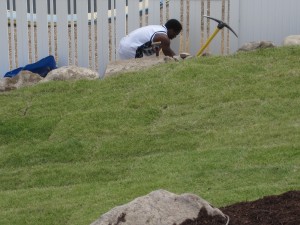How to plant a plant: part two
Posted on September 27, 2009 by sonjabarrie
Planting a plant in Herriman is easy when you follow these steps:
- dig shovel into ground
- stop ears ringing from vibration of shovel hitting rock
- spend 2 hours digging out said rock
- dig shovel into ground
- stop ears ringing from vibration of shovel hitting rock
- spend 2 hours digging out said rock
- take a well earned break
- get pickaxe and break up clay in bottom of hole
- take pickaxe and make sure hole is at least twice as wide as the pot you are trying to plant
- dig out clay and rocks dislodged with the pickaxe
- if clay is wet take 4 hours to get wet, soggy, slimy, sometimes smelly clay out of hole, scraping it off the shovel after each shovel full
- think really hard about whether gardening is a vocation you really want
Digging holes the Herriman way
Those of you who follow me on FaceBook may have realized by now that although gardening is a vocation I am passionate about I am still trying to decide if gardening in Utah is the right place to have this passion! Devan in the picture above helped us for a couple of afternoons and even paying him couldn’t entice him back!
Well, in case you are gardening in Herriman or anywhere that has a lot of clay you could probably use some tips as to how to get plants to grow in it. Most people’s idea of putting in a plant is to dig a hole, add water (some people seem to think this is an optional step) fill the hole back in and keep their fingers crossed.
I have dug up trees that have been put in this way and after getting them out of the ground I can see why they died. The problem with clay is it is fairly solid, when it’s wet you can mold plates and jugs with it and if you pour water into a hole made in clay the water stays there and does not drain away. In fact it is like putting water into a bucket, the sides and bottom are impervious.
This means if you plant a tree or shrub in a hole dug in clay you are in essence putting your pant inside a bucket and you can watch it drown in very short order. Plants need water, that’s true but while they need to get wet that water must drain away so you need to condition the clay in order to make that happen. It’s not as hard as it sounds and it’s well worth the effort.
To start with you need to make the hole twice as deep as the pot calls for, and at least twice as wide if not wider, especially if you are planting trees. If the soil is dry which it is here in Herriman, the bottom of the hole can be like concrete, this is where the pickaxe comes in handy, break up the bottom of the hole and put in some gravel as that will aid drainage, mix it up with the clay at the bottom of the hole. Then get lots of composted bark or wood chips and mix it with more of the clay to bring the bottom of the hole to the right height. As it’s clay you can use Soil Building Compost, Soil Pep, or Nutrimulch, find something appropriate at your local nursery.
Next sprinkle a generous amount of bone meal, this stuff is fantastic and has nitrogen and phosphorus which are both needed for healthy plants and the best part is if it gets on the roots it won’t burn them like regular fertilizer. Put water into the hole to wet the compost you added and to make sure the root ball isn’t going into a dry hole.
I also use a root hormone on every plant I put in. It’s not crucial but after going to all that trouble to get a good hole in horrible clay I figure anything I can do to ensure success is well worth it. The stuff I use is called “MYKE brand mycorrhizae” and there are many kinds available at nursery’s, spread the appropriate amount of MYKE over the rootball. DO NOT BREAK THE ROOTBALL. The MYKE or whichever brand of root hormone you use must be in direct contact with the roots OR the outer surface of the rootball. Put the rootball into the hole so that it sits at the bottom of the hole.
As you put the soil back into the hole around the rootball mix more compost and bark with the clay along with more bonemeal, mix approximately 20-30% mulch to 70-80% existing soil. When the hole is about half full water again to completely saturate the root ball and the soil mix. Use a garden hose to deep soak the hole so that all air pockets are eliminated. Finish filling the hole with soil mix and bone meal, the top of the filled hole should slope gently away from the trunk, with the top of the original soil ball visible after planting. Finally build up a kind of bowl of soil at the edge of the root ball to direct water to the roots.
You can now place top mulch around the tree or shrub to help keep moisture in and weeds out but make sure the mulch doesn’t touch the trunk. Deep soak by turning on a hose to a slow trickle and place the nozzle within the basin until the soil is completely saturated, how long you do this will vary according to the size of the root ball and the hole you dug.
In Utah or any other hot state, sprinkler water is not enough for newly installed trees and shrubs. Large caliper trees need 20-45 minutes of deep soaking 2-3 times per week, depending on weather and temperature, for the first three months. Deep soak once a week, in addition to sprinkler watering, for the rest of the first growing season. Drought tolerant plants may be able to survive without weekly soakings after the first month or two. Deep soak trees and shrubs twice monthly during the second summer, in addition to sprinkler watering. Plants grown in clay soil need less frequent watering than those in sandy soil simply because as mentioned above, clay holds on to water. Apply at least 2 gallons of water per inch of trunk caliper at each watering.
So there you have it, easy peasy once you understand whats involved. Follow the steps above and I can almost guarantee your tree or shrub will not only live but thrive!
Leave a Reply










 Facebook
Facebook